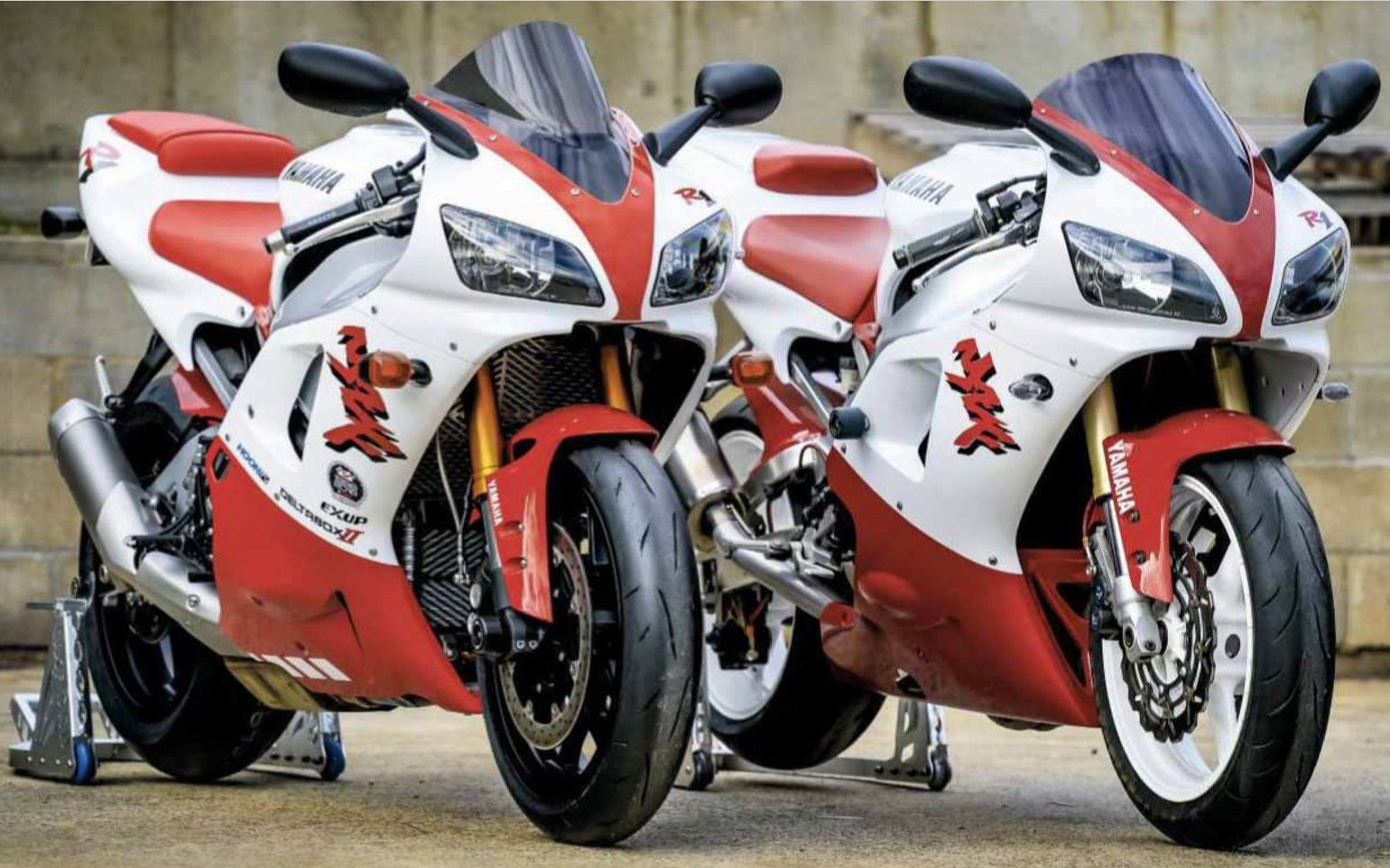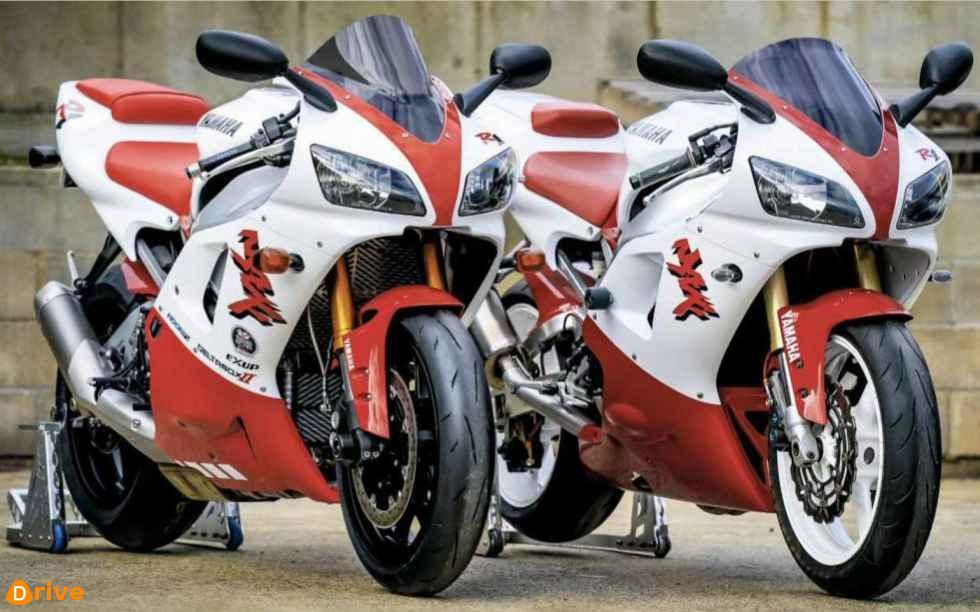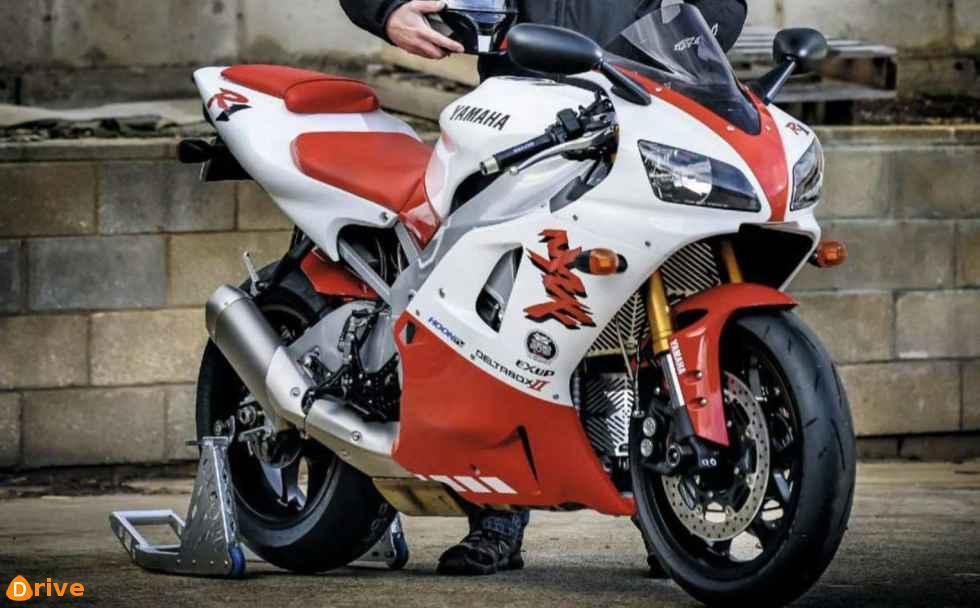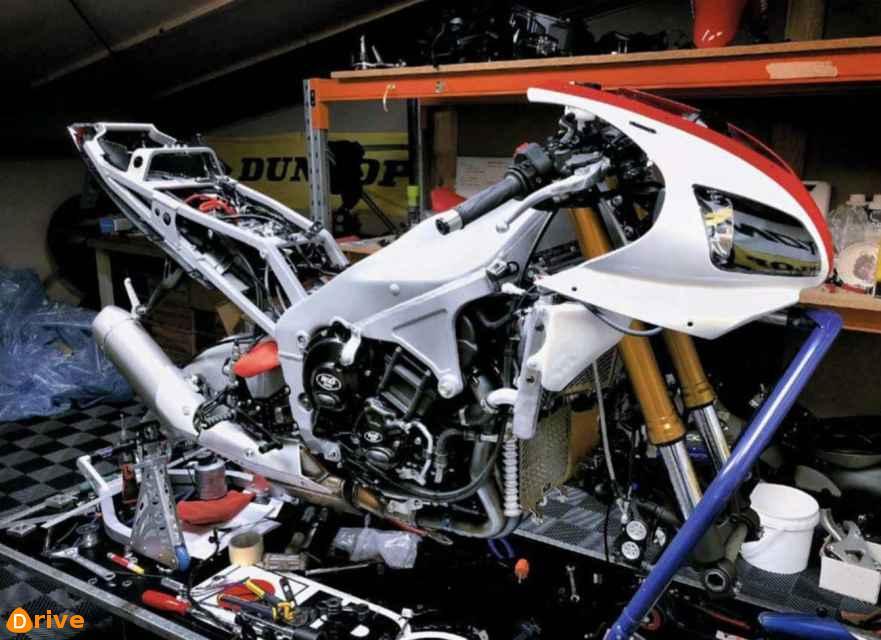
For once, a shallow gene pool is a good thing… To pay tribute to the R1 on its 20th anniversary, Mark Boxer combined the body of the original with the mechanicals of a 2018 bike
INCESTUOUS MARRIAGE
 Mark’s bike (left) meets its near-identical twin: bike No2 to have been released into the wild in 1998
Mark’s bike (left) meets its near-identical twin: bike No2 to have been released into the wild in 1998
USING NEW PARTS on old bikes is nothing new – itmore or less dates back to the point when enoughdevelopment had happened to consider technology newor old. Ever since, motorcyclists have been retro-fitting newparts and ideas to oldermodels to help themalong as they age. Very few new-on-old conversions take it as far as this R1. Outwardly, it’s a 1998model, in the preferred red andwhite. Then younotice the radial brakes. And the 10-spokewheels.
Oh look, KYBAOS forks – and that’s not the original swingarm. Those engine cases look different, too… It’s a bike that takes a second look to appreciate fully, but that second glancewill be a long one: just about the only bits you can consider to be old-tech are the frame and bodywork. Beyond those familiarmodern classic lines is the full running gear froma2018R1: nothing lost, omitted or sacrificed for the sake of ease.
It’s a special build that’s impressive and divisive in equal measure: online reaction varied from purists spitting olive drab-coated fasteners at such butchery of a beloved classic, to stunned adulation from those who appreciate the difficulty of pulling it off. We were somewhere in between, so we spoke to Mark Boxer, the man who masterminded the hybrid build.
Who? When? Why? How?
The deciding factor in getting the build on a workbench was an Aussie bike parts distributor approaching Mark about a promo bike for their spares and accessories. But the real genesis of the new-old hybrid is older than that. “I actually had the idea to do this for the 25th anniversary of the Fireblade last year,” Mark explains. “But I wasn’t able to fund the build alone. Then I was approached by a company who wanted a bike, and I pitched them my crazy idea. I wasn’t sure what they’d say, but once we’d crunched the numbers, they gave me the go-ahead late last year.
With theR1 turning 20in 2018, it was the perfect bike.” TheR1 is special to any sportsbike-loving nation, but the Aussies have an extra affinity with them. The launch was held at Phillip Island, and the first shipment of bikes headed south to reach the colonials before anyone else. Bikes number 1 and 2 – the first of each colour – are Down Under. Number two ( the first in red and white) was discovered by Mark when he borrowed one for pics next to his finished creation.
The owner was understandably pleased to discover he owns a bit of sportsbike history The donor R1 was a typical 20-year-old example, the less than complete care lavished upon it had seen it change to blue from red as well as get a bit tatty. The second bike – a 2018 R1 – had only covered 20km to get to the workbench. Both were stripped: then the job of mating technology several generations removed began.
Nip, tuck and cut
Mark roped in the workshop space and assistance of Race Bike Services near Adelaide for the build. They started with making the big bits fit: the 1998 frame and chassis parts were measured, then the verniers and tape measure ran over the swingarm, yokes and forks from the 2018 donor. Surprisingly, the differences were minimal: the swingarm width and chain run are very similar. But the yoke dimensions are all but identical, the fork length just 5mm shorter on the latest bike..
 Swingarm width and chain run are almost identical between both bikes
Swingarm width and chain run are almost identical between both bikes
“Luckily on the drive side of the swingarm the offset to the chain and the centre of the rim was almost identical,” says Mark. “All we needed to do was to machine about 1mm from the drive side, then the chain guide needed a part machined down to fit deeper into the arm. Luckily it’s a reasonably hard material and could be done carefully by hand using a mill. “The other side of the swingarm was machined down by 5mm and the bearing recessed in further, but itwas a fairly straightforward job as I had Johnny the machinist helping me and he’s a guru.”
The steering stem is considerably longer on the new bike and couldn’t be used. So the 1998 stem was pressed out, then fitted into the new yoke. The 2018 bike’s redundant stem has a neat machined/drilled design on the top which is purely cosmetic, but Mark had the style cut into the 1998 stem so the transplant looks standard. In 1998, we dealt with tankslappers like men, but with another 50bhp to stir a bike with a shorter wheelbase, the 2018 bike is tamed with an electronic damper attached to the frame near the bottom yoke.
To transfer it to the older bike, a lug was machined to mount it, then integrated in to the standard 1998 fairing bracket to secure to the frame, with an extra clamping bolt added to spread the load. The shock and linkagemounts on the frameweren’t touched, but the slight difference in widths and diameters was accounted for by new spacers with dimensions suiting both the 1998 frame and 2018 suspension parts to avoid modifying either.
The suspension linkage rocker and tie bar wouldn’t fit, so a new one was designed and calculated to match the standard ratio and give the shock a full range of travel without fouling the frame, as the 2018’s standard rocker threatened to do. A mock-up was 3D-printed, tested with a springless shock before a finalised part was machined and paired with a set of offset tie bars. With the rolling stock sorted, getting the engine was the next priority.
Yamaha pioneered the stacked gearbox design on the R1 and still orient the main parts in this same way, and the 2018 engine is about as compact as a modern litre bike motor gets, so the basic fit wasn’t a problem – it clears the inside of the frame rails, the throttle bodies and injectors fit well, too. The engine mounts are all different, though, so Solid Engineering’s saw and CNC machine saw a lot of action removing and refabricating themounts. All themounts were moved, as well as moving the sidestand bracket further back on the frame.
The biggest change is the front engine mount on the cylinder block – the 1998 grips the back of the cylinders, where the current model hangs them from the front. New triangular mounts were machined up, then a chassis jig created to hold the engine and frame square before welding new mounts in place. More new lugs were made for other main bolts. While there was welding going on, the pillion footpeg bracket lugs were cut off and a new set of vertical threads welded in to accept the 2018 counterparts, and the subframe braced to support them properly.
One last piece of major metalwork was the fuel tank: the airbox is larger on the new bike, and required the lower side of the tank and a new piece of steel formed and welded to clear the complete 2018 airbox and attached ancillaries. A new flange was machined and welded in place for the 2018 fuel pump: the carburetted original had a fuel tap and low pressure external pump, whereas the new one has an internal high-pressure pump to feed the injectors, so the hybrid needed the newpump inside the old tank.
‘THE COMPLETE WIRING HARNESS FROM THE NEW BIKE WAS USED, WITH SOME VERY MINOR TWEAKS TO FIT AND CONNECT THE 1998 LIGHTING’
Attention to detail
With engine and suspension successfully transplanted, Mark and his chosen help/specialists were able to fill in the details to make the ‘retrotech’ conversion successful – retaining the essence of the original but ensuring the technology and detail is all modern day. The frame needed refinishing thanks to a combination of neglect, use and the new fabrications. Anodising was considered, but an as-new finish wasn’t guaranteed, so it’s powder-coated in the closest tone they could find to the original chassis finish.
 This is no Frankenstein’s monster. The 98/18 hybrid on the operating table is being worked on by men driven by passion and backed up with considerable talent
This is no Frankenstein’s monster. The 98/18 hybrid on the operating table is being worked on by men driven by passion and backed up with considerable talent
The 2018’s black swingarm got a dose of the same to match. Keeping the R1 fully-functioning and road legal was a key consideration: we’d love to see it with a 1990s-spec slip-on can, and ditching stuff like the ABS would make it ride that little bit better. But Mark and the team didn’t want to compromise the depth of the transformation. The complete wiring harness from the new bike was used, with some very minor tweaks to fit and connect to the 1998 lighting.
New CAN bus-compatible LED headlight bulbs were needed to ensure the lighting ECU would power them up and not report a fault code, as they would with simple H4 halogens as usually fitted to those big fox-eye lamps. The Inertial Measurement Unit, ABS pump and other 21st-century electric components were housed under the seat, distributed between a modified 1998 plastic undertray and a new aluminium support where the old parts couldn’t be acceptably adapted. The new dash is used, too: the fairing bracket was fitted with a new back plate to support the TFT screen, and powder-coated black so you’dnever know it had been cut and modified. All the new switchgear are used – they weren’t even separated from Yamaha clip-ons.
The full 2018 exhaust is used, and is one of the few parts that required a slight compromise on the seamless blending of parts. The catalytic converter was too wide for the tail end of the bellypan to be retained without it melting into a noxious red and white pool, so it was trimmed to clear the searing hot cat chamber. “As the link sits lower in the ’98 bike I had to notch out the top of the cat converter and box it in a bit lower, but that didn’t affect the cats themselves as they’re in the front of the pipes.
Ideally, running a de-cat pipe would have been the best solution, but the engineer passing the bike for the road wanted the cat and muffler to be as per standard with the late model engine. That being the case though I would have been able to run the full early bellypan, but either way I tried to make it work as best as possible. I don’t think it came up too bad.” Serious R1 nerds might notice the bellypan isn’t quite correct: the pattern plastics are for a 2000 model, with an extra exhaust vent. They’re identical otherwise, and were the only option available on a tight build schedule.
The new ignition barrel is needed and used – the steering lockworks, too, as Yamaha kept the barrel’s position in relation to the cut-out on the frame almost identical. The new fuel cap is a direct fit, and the seat lock needed a simple reconfiguration of the tumblers to accept the 2018 key, so it’s the complete set operated by one genuine Yamaha key. Neat. Ram-air has also been sacrificed: the original didn’t have it, and there isn’t room for a discreet duct. Instead, the open cavity behind the headstock and above the rad now has an aluminium plate to guide cool air in from the front of the bike.
Does it work?
Of course: as far as the engine knows, it’s still between the frame rails of a 2018 bike, as every component and sensor it was designed for is attached and functioning. Both wheels have speed sensors for the rider aids, and the IMU still measures forces. It fired, ran and didn’t register a fault code in its blissful electronic ignorance of the surgery it had been subject to. “It felt great on the first ride, and was kinda like riding a brand new bike,” says Mark. The traction control and anti-wheelie work as they should and the bike was stable.
The one thing neither the 1998 or 2018 bikes had over the new one is the induction noise; because it’s going over the radiator and drawing from under the tank, it really roars! I’ve been away since it was finished (Mark organises Moto Time Attack here in the UK – CN) so it’s not done a lot of miles, but now I’m home I’m going to be spending a lot more time on it”.





